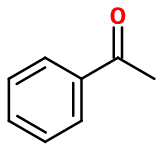
Photo credits: ScenTree SAS
| Company | Ingredient Name | ID | Comments | Naturality | Certifications | MOQ | Purity |
|---|---|---|---|---|---|---|---|
|
|
ACETOPHENONE | - |
Visit website
|
- | 10 grs | - |
General Presentation
-
CAS N° :
98-86-2 -
EINECS number :
202-708-7 -
FEMA number :
2009 -
FLAVIS number :
07.004
-
JECFA number :
806 -
Volatility :
Head -
Price Range :
€€
Physico-chemical properties
-
Appearance :
Colorless liquid -
Density :
1,027 -
Refractive Index @20°C :
Data not available. -
Optical rotation :
Data not available. -
Vapor pressure :
Data not available. -
Flash Point :
81°C (177,8°F)
-
Molecular formula :
C8H8O -
Molecular Weight :
120,15 g/mol -
Log P :
1,6 -
Fusion Point :
20°C (68°F) -
Boiling Point :
202°C (395,6°F) -
Detection Threshold :
200 ppb
Chemistry & Uses
Uses in perfumery :
Acetophenone is used in fruity notes of red berries (cherry among others), in bitter almond notes and in white flowers accords (tuberose, jasmine).
Year of discovery :
Data not available.
Natural availability :
Acetophenone can be found in Cistus EO, and in the scent principle of Cocoa Absolute, beef, concord grapes and raspberry among others.
Isomerism :
Acetophenone is a constitutional isomer of Phenyl Acetic Aldehyde, which has a rosy and honey smell. These two molecules has a very similar smell.
Synthesis precursor :
Acetophenone is used for the synthesis of Phenyl Ethyl Alcohol.
Synthesis route :
Acetophenone is obtained by synthesis in the Hock process, or cumene-phenol process. It is recovered as a by-product of this reaction, by distillation of the reaction medium, having a high boiling point. This process consists in synthesizing phenol from benzene, propylene and oxygen. It is also used to synthesize cumene (by-product) and acetone (final product).
Stability :
Stable in perfumes and in diverse functional bases
Other comments :
Data not available.
IFRA
IFRA 51th :
This ingredient is not restricted for the 51th amendment
















